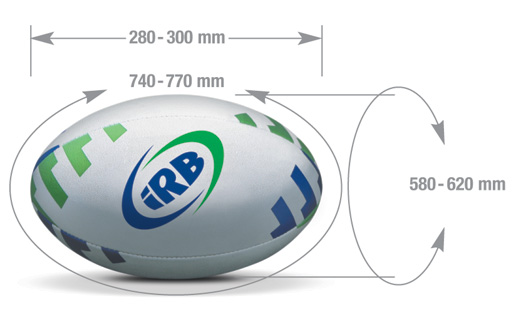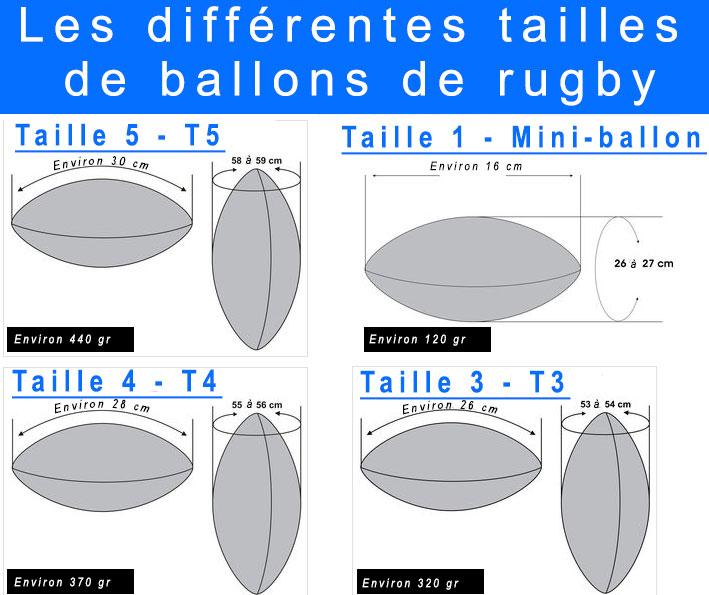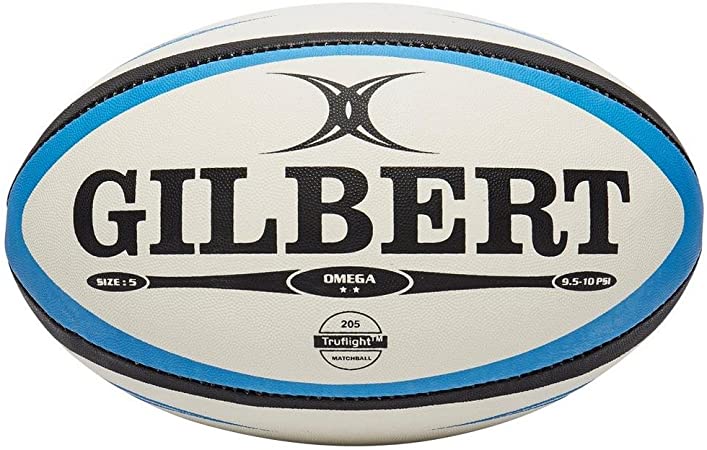Technical sheet - rugby balls
- Définition
- What sizes of rugby balls?
- Training or match ball?
- Rugby ball brands
- The wide variety of rugby balls
- FAQ
- Video presentation of the rugby ball
- Download the rugby ball advice guide in PDF format
How to choose the right rugby ball? the question is relevant as the offer has expanded in recent years with new practices such as touch rugby or rugby 7, supporter balls, replicas...
In this guide we will provide you with as many answers as possible to your questions to help you in your research.
Rugby ball: technical information
The IRB specifies that the rugby ball must be oval and made up of four panels.
It can be made of leather or similar synthetic materials. The material can be treated to make the ball water resistant and easier to hold. It must weigh between 410 and 460 g
Air pressure at start of game: 65.71 to 68.75 kilos pascals, or 0.67 to 0.70 kilograms per square centimeter (size 5).
The rugby ball is made up, in addition to the covering of four sewn panels covered with pimples (or grip) to ensure better grip, of two to four polyester layers and a latex or butyl bladder.

Rugby ball: What sizes?
There are 3 sizes of rugby balls for the game depending on the age of the players:
- Size 3: 5 to 9 years (Pressure of 0.50 à 0.55 bars)
-Size 4: 10 to 14 years old and female (Pressure of 0.55 to 0.60 bars)
- Size 5: 15 years and over
Added to this are the first two sizes (T1 and T2) which are more intended for collectors and/or for small children.

Rugby ball: Training or match ball?
It depends on the level of play and usage. The ballons de match will be more popular with kickers and will allow in particular better precision in the strikes, to hit further and to better lengthen the pass. But the training balls will be perfect for everyday use .
The main brands of rugby balls
Gilbert, the pioneering brand, has a hegemonic position in the rugby ball market. It equips most of the major rugby nations with the notable exception of the All-Blacks who are with adidas, and all the TOP14 clubs among others. It is one of the few brands to offer a wide range of match balls.
Other brands offering rugby balls, such as adidas, RTEK, Canterbury or BLK, generally focus on training balls.
The wide variety of rugby balls
In addition to the balls intended for the competition - match or training - the major brands have created replica balls of the major nations and rugby clubs, supporter balls, beach rugby balls or fancy balls...
Added to this are the balls specially designed for new rugby practices such as Touch Rugby where the SEVEN.
| SIZES | CIRCONFERENCE | WEIGHT | LENGTH | PRESSURE | USE | OLD |
| 1 | 26 à 27 cm | 120 gr | 16 cm | 0.67 à 0.70 bars | Hobbies | - |
| 2 | 46 à 48 cm | 210 gr | 24 cm | 0.67 à 0.70 bars | Hobbies | - |
| 3 | 54 à 54 cm | 320 gr | 26 cm | 0.67 à 0.70 bars | Compétition | 5-9 ans |
| 4 | 55 à 56 cm | 370 gr | 28 cm | 0.67 à 0.70 bars | Compétition | 10-14 ans + féminines |
| 5 | 58 à 59 cm | 440 gr | 30 cm | 0.67 à 0.70 bars | Compétition | +15 ans |
| SEVEN | 58 à 59 cm | 440 gr | 30 cm | 0.67 à 0.70 bars | Rugby Sevens | +15 ans |
Summary table of rugby ball characteristics
Rugby Ball FAQ
– Do the balloons come inflated?
No, the balloons are always delivered deflated. They inflate with a simple needle and a bicycle pump. We offer you the needle for any T5 ball purchased.
– How long does a rugby ball last?
It all depends on your use, but a training ball used regularly, especially if you play on a more abrasive synthetic turf, lasts two years on average. Afterwards you will still be able to use it but the grip will generally have disappeared.
– Are the balls leather or synthetic?
Purists may regret it, but synthetic has completely supplanted leather for game balls. Synthetic is lighter, flies farther, doesn't warp or waterlog when it can... the leather was no match!
– Can we personalize an individual rugby ball?
No it does not happen. Several brands offer personalize your rugby balls in your colors and with your logos, in particular GILBERT and RTEK but from 25 pieces.
– What is the point of following inflation recommendations?
It is important to follow the brands' recommendations regarding ball pressure, especially for use in competition. This is because a well-inflated ball will travel faster through the air and a longer distance when kicked. An over-inflated balloon risks bursting and will lose precision. A balloon that is too underinflated will move slower and it will be more difficult to control its trajectory.
For example, on Gilbert balls, like the Omega competition model below, the pressure measurement is indicated on the ball: 9.5-10 PSI (Pounds per Square Inch),which is equivalent to a pressure of approximately 0.66-0.69 bar.

BGILBERT OMEGA match ball. The pressure is indicated on the right under the T of GILBERT
